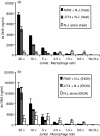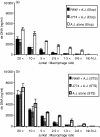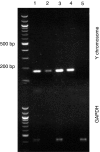The role of macrophages in the in vitro generation of extracellular DNA from apoptotic and necrotic cells
- PMID: 15819697
- PMCID: PMC1782131
- DOI: 10.1111/j.1365-2567.2005.02130.x
The role of macrophages in the in vitro generation of extracellular DNA from apoptotic and necrotic cells
Abstract
Cell death is a ubiquitous process that occurs by apoptosis or necrosis depending on the triggering event. While apoptotic and necrotic cells differ biochemically, both are cleared by macrophages for elimination. The process is very efficient, although DNA can appear in the blood in various clinical conditions associated with cell death. To define the role of macrophages in the generation of extracellular DNA, in vitro experiments were performed, assessing the release of DNA into the media of apoptotic or necrotic Jurkat cells cultured with RAW264.7 or J774 macrophage cell lines. DNA was measured by a fluorimetric assay using the dye PicoGreen. In these experiments, while necrotic cells alone did not release DNA, in the presence of macrophages, significant amounts of DNA appeared in the medium. This DNA contained sequences from the Jurkat cells and had reduced molecular weight in comparison to cellular DNA. Furthermore, coculture of macrophages with enucleated necrotic Jurkat cells did not release DNA, suggesting that the DNA came from the dead cell. In contrast, Jurkat cells made apoptotic by treatment with either staurosporine or etoposide spontaneously released DNA, while coculture with macrophages caused a decrease in the DNA released. With apoptotic cells, the DNA in the medium showed low molecular weight and laddering whether or not macrophages were present. Together, these results indicate that macrophages play an important role in the generation of extracellular DNA from dead and dying cells, with the effect dependent on how the cell died.
Figures






References
-
- Farber E. Programmed cell death: necrosis versus apoptosis. Modern Pathol. 1994;7:605–9. - PubMed
-
- Columbano A. Cell death: current difficulties in discriminating apoptosis from necrosis in the context of pathological processes in vivo. J Cell Biochem. 1995;58:181–90. - PubMed
-
- Martelli AM, Zweyer M, Ochs RL, et al. Nuclear apoptotic changes: an overview. J Cell Biochem. 2001;82:634–46. 10.1002/jcb.1186. - DOI - PubMed
-
- Ren Y, Savill J. Apoptosis: the importance of being eaten. Cell Death Differ. 1998;5:563–8. 10.1038/sj.cdd.4400407. - DOI - PubMed
Publication types
MeSH terms
Substances
Grants and funding
LinkOut - more resources
Full Text Sources
Other Literature Sources

